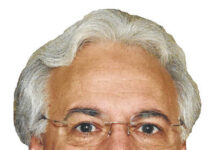Under pressure to meet a 7 percent investment return target, Luzerne County’s employee pension fund overseers are shifting more money from bonds and other fixed income to alternative investments.
Alternative investments include hedge funds and private equity, real estate and credit.
The public has an interest in the pension because annual taxpayer funding is required.
This year’s contribution is $12.9 million, with $8.5 million from the general fund operating budget and the rest from the state and other revenue streams. The proposed 2019 budget projects a $570,000 general fund increase for the pension subsidy, although officials are awaiting further calculations from the actuary to be sure.
Pension fund investment adviser Richard J. Hazzouri, of Morgan Stanley, worked with the actuary and county Retirement Board members last year to come up with a revised blueprint of investment types, known as an asset allocation plan, that calls for an increase in alternative investments.
The change is warranted, Hazzouri said, due to “compressed” returns and higher volatility in both stocks and bonds.
Before Morgan Stanley started converting to the new plan in July, the investment mix was 48.6 percent public stocks, 38.6 percent fixed income and 11.3 percent alternative, with the remaining 1.5 percent held as cash.
When changes are fully implemented, the investments should be 55 percent stocks, 20 percent fixed, 20 percent alternative and 5 percent cash, Hazzouri said. The cash portion was upped because the fund now pays approximately $19 million in pensions annually, officials said.
Hazzouri said he expects alternative investments to continue increasing, with the asset allocation plan setting a 35 percent cap in that category.
The three negatives generally associated with alternative investments, according to Hazzouri: less transparency, higher fees and longer waits to cash out.
Hazzouri said he and his team have been performing extensive due diligence and vetting before selecting alternative options, including historical analysis of after-fee investment returns.
The pension fund was valued at $239 million as of Sept. 30.
A total $28.75 million has been or soon will be moved from fixed income to these alternative investments, according to Hazzouri’s retirement board presentation last week:
• Axonic Credit, $7 million
• SkyBridge Series G, $5 million
• WorldQuant, $4.75 million
• Millennium Strategic, $12 million
Ongoing struggle
The county’s pension is currently 73 percent funded. Subsidies at $13 million and higher are projected to linger through 2035, the actuary’s reports have shown.
Shoring up is necessary to close a shortfall that emerged years ago, when investment earnings and employee contributions stopped keeping pace with obligations for future pensions that are guaranteed by law. Two other drivers cited by the actuary: People are living longer, and the revenue projected from investments had been unrealistically high.
In response, the retirement board voted in April to reduce the actuarial investment earning target from 7.25 percent to 7 percent.
Hazzouri has said his group will continue pushing for maximum returns without exposing the fund to excessive risk that could lead to devastating losses. However, he has projected more dismal short-term gains around 4 percent the next few years due to the market climate.
A target in the 6 percent range would be more realistic, Hazzouri has said, but further target reductions would boost the county’s required contribution.
In 2017, the fund’s investment return was 11.63 percent. The year-to-date gain in 2018: 0.29 percent.
Morgan Stanley is marking its 10th anniversary overseeing the county fund this month and has generated $120.5 million in investment earnings during the decade, net of expenses, Hazzouri said.
Independent of investment returns, the fund paid out $33 million more than it brought in from employee and taxpayer contributions in that period, Hazzouri said. A total $85.9 million in public funds have been pumped into the pension to keep it stable since 2008, records show.
The fund had plunged from $210 million in 2007 to $151.8 million before Morgan Stanley was retained.
“What I don’t want to have happen is that we go back to where we were 10 years ago,” Hazzouri told the board. “Ten years ago, we took on far too much volatility in the portfolio, and there were consequences to that.”




